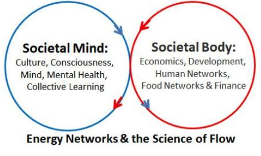What are the Energy System Sciences?
Today’s 2nd Scientific Revolution (the Systems one) is still in its pre-Copernican stage. Systems approaches have been emerging under a wide variety of names in a large number of disciplines, for example, chaos, complexity, ecology, integrative medicine, resilience and computational networks. But these interrelated disciplines have not coalesced around a common language or vision of themselves as a whole.
We use the “Energy System Sciences (ESS)” as an umbrella term for those disciplines that explore: 1)Energy Dynamics’central role in fueling motion, creating organization, and driving change; and 2) Morphodynamics (the geometry behavior), the role attractive and repulsive forces play in giving shape, form and organization to all things. This umbrella includes disciplines such as: nonlinear dynamics, nonequilibrium thermodynamics, self-organization theory, resilience, regeneration, theoretical ecology, andPanarchy.
The Energy Systems sciences have several advantages.
-
Energy dynamics apply to all systems: living, nonliving, and supra-living ones such as ecosystems and societies.
-
Energy and morphodynamics give rise to mathematically-precise patterns and principles, which allows us to do relatively rigorous science on them, including quantitative measures of systemic health and a certain degree of prediction.
-
Energy dynamics naturalizes such ethereal phenomenon as intelligence, mind, culture, and consciousness and integrates them logically into the more material phenomenon such as body, social structures and economies.
So, how does one link human- and life-science research ranging from psychology and consciousness to finance, medicine and urban planning? You start by recognizing a common core principle: all systems are flow-networks. A flow-network is any system whose existence arises from and depends on the circulation of critical resources throughout the entirety of their being. Living organisms depend on the circulation of nutrients and oxygen. Ecosystems depend on the circulation of carbon, oxygen, water, etc. Economies and healthcare systems depend on the circulation of money, resources, goods and information.
Next you show how universal principles – such as pressure, developmental cycles, and ‘energy as fuel’ – help reframe and reorganize a great deal of existing research in various human- and life-science fields. You then show how universal patterns – such as fractal growth patterns – produce measurement tools that improve the power of research while also connecting to existing outcome-measures in various fields. This latter allows longitudinal studies using existing data.While ecological flow-networks are particularly advanced, the advantage of applying universal principles to public health is that it avoids the question of whether the results are merely a metaphoric extrapolation from ecosystems.
Finally, you help heal the hard/soft science divide both with: 1) more rigorous tools and coherent theory; and 2) by providing a scientific theory of “mind-body” integration and collaborative union that applies to levels from individuals to societies (e.g. culture/economy interaction).Mind-body integration is natural in this system because energy dynamics give rise to both organization and information (in the form of little patterned energy-trails). Universal patterns of growth and development leads to a mutually-affecting mind-body integration in which societal “mind” factors – such as intelligence, beliefs, culture, paradigms, consciousness, mental health, and collective learning – are inextricably linked with societal “body” factors such as economics, finance, food networks, infrastructure, and human networks.

Measuring Regenerative Vitality
Dr. Goerner and the Research Alliance for Regenerative Economics (RARE) have used ESS to develop quantitative measures of systemic socio-economic health. These provide more effective ways for practitioners, policy makers and enterprise leaders to track the direction and impact of their efforts toward societal and organizational.See:
Fath BD, Fiscus DA, Goerner S, Berea, A. & Ulanowicz, R. 2019. Measuring Regenerative Economics: 10 principles and measures undergirding systemic economic health, Global Transitions, 1(2019): 15-27.
This approach to quantitative measures is just as groundbreaking as the Regenerative (ESS) framework itself. We are not simply creating more ways to assess desirable outcomes; we are developing ways to measure the health of the human system itself using the causal factors that support a system’s ability to remain vibrant for long periods of time. Factors such as resilience, efficiency, circulation, structure, relationships, values and adaptability, for example, are central.
The underlying premise is that healthy human systems, ones designed to obey the long-term laws of systemic health, naturally become oriented towards the socially-, economically-, and environmentally-desirable outcomes we currently measure. Just as assessing human health requires measuring multiple factors such as blood pressure and glucose levels, so combining multiple human resilience and regeneration factors gives us a clearer picture of how to develop healthcare systems – ones that can live long and prosper both internally, and in relationship with the other nested social, economic, financial, political an environmental subsystems in which they are embedded.